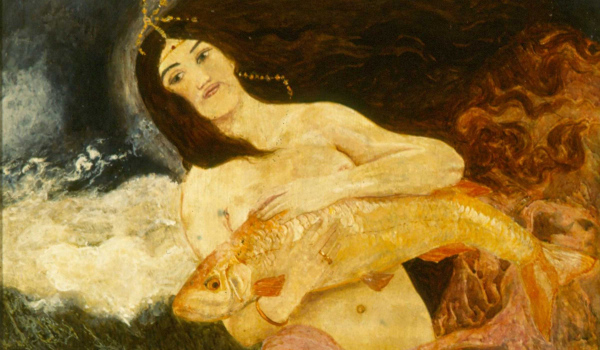The Palazzo Roverella in Rovigo, Italy has been hosting the Arte e Magia exhibition since the beginning of the Fall and continues through the end of January 2019. The institution’s site states:
“Esotericism fascinates just about everyone, even great masters such as Kandinsky, Rodin, Munch, Basile, Klee, Previati and Mondrian.
“Here at Palazzo Roverella, we are ready to bowl you over with a great event dedicated to art and magic.
“We will take you on a voyage of discovery through the esoteric movements of the 19th and 20th centuries that influenced European painting. Get ready to be bewitched by mysteries, dreams, psychoanalysis and the subconscious. Esotericism, symbolism, and historical avant-garde.”
and:
Leave your rationality behind before entering
Let demons and spirits, witches and wizards, vampires and ancient gods take you by the hand. Abandon your certainties, allow yourself to be taken down into the most inaccessible recesses of the human soul, and discover a truly unique period in the history of the Western world.
Europe, sometime between 1880 and 1925. A time when interest in esotericism and hermetic doctrines resurfaced with a vengeance, encompassing the figurative arts, literature and architecture in its aura of mystery.
The desire to explore dreams, the occult, the subconscious became a guiding thread that bound together two emerging movements, Symbolism and psychoanalysis, and, shortly afterwards, also the early 20th century avant-garde movements, Futurism and Abstractionism.
Sascha Schneider, Astarte
Marcel Lenoir, Invocation à la Madonne d’onyx vert
When the lips sleep the soul wakes up
Any initiation begins with a promise: that the initiated will not reveal the occult doctrines they are learning. And that’s precisely how the journey through Art and Magic opens: with an invitation to silence. A gesture – a finger or hand over sealed lips – bounces from one work to the next, from Giorgio Kienerk to Odilon Redon, enjoining visitors not to divulge the secrets they are about to discover. An invitation to silence our reason, and listen to the whisperings of our subconscious.
Seeking light
It is only by accepting this invitation that you will be granted access to the Temple, the second stage of the journey of initiation, which will lead you to discover the secrets of esoteric architecture and decipher its mysterious symbols.
Waiting to greet you, at the exit, is Light: auras, emanations and luminous beams. Representations of physical and spiritual phenomena, featuring in works that – from Previati to Mondrian – underscore the passage from symbolist to modernist and avant-garde aesthetics.However, there can be no light without darkness. Through the next three stages of the journey, you will have to extricate yourself from the tentacles of dark, impressive, perturbing works arising out of the subconscious of Auguste Rodin, Edvard Munch and Vasilij Kandinskij.

Romolo Romani, Ritratto di Dina Galli
The night and its invitees
This is the heart of darkness of the entire exhibition. It is the kingdom of devils, witches and wizards, of lords of darkness and its nocturnal vampires and animals. And, of course, ghosts, starring in a section dedicated entirely to Spiritism, in which the late nineteenth century bourgeoisie developed an ardent, enthusiastic interest, leading to an outburst of séances. These are portrayed through a series of period photographs and two small séance tables, purposely produced by Thayaht and Julius Evola.
Eugene Grasset, Trois femmes et trois lupus
Paul Sérusier, L’Incantation
Looking East
From the spirit to the soul, the initiation concludes with a return to light, radiating from the Far East and flaring up a Europe-wide passion (that is still alive today) for mythologies, doctrines and oriental religions. This explains the interest of many artists, such as František Kupka, Jan Toorop and Nicholj Roerich, in Buddhism and Yoga, and the birth, at the turn of the century, of a utopian, nonconformist community near Ascona, called Monte Verità. Many personalities, from Carl Gustav Jung to Herman Hesse, stayed here, practising nudism and vegetarianism, as an escape from the shackles of industrialized civilization.
A sublime art
Art and Magic is an oasis where you are asked to leave your rationality behind before entering. If you accept this invitation, you will discover that, while it is true that the sleep of reason produces monsters, it is equally true that it can also generate sublime art.

Louis Welden Hawkins, Woman with blue curtain
www.palazzoroverella.com/en/exhibition/arte-e-magia/.


 Romolo Romani, Ritratto di Dina Galli
Romolo Romani, Ritratto di Dina Galli

 Louis Welden Hawkins, Woman with blue curtain
Louis Welden Hawkins, Woman with blue curtain
